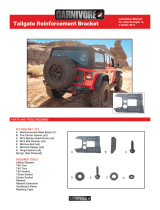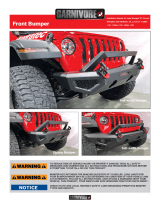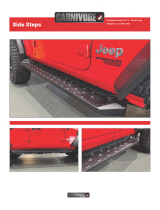Page is loading ...

GETTING STARTED
Cover your work surface and clean up
any messes right away.
Plan out your habitat before you begin,
that way your plants and accessories will
each have plenty of room. For ideas,
refer to the picture and helpful planting
guide. If you need help, ask an adult or
older friend to craft with you.
Although the seeds included in your
garden are food grade, the plants are
intended for decorative purposes only.
CRAFTING
Before planting you will want to get all of the accessories ready.
Volcano
Lay the volcano flat on your work surface, color side facing up.
NOTE: Remove protective plastic film before assembling.
Use the red sparkle paint to add dimensional lava details to the volcano.
Leave it flat until it’s completely dry.
When the volcano is dry, peel the release paper from the adhesive.
Assemble the volcano by rolling it into a cone and sticking it together.
Fold the bottom tab up. Add the extra adhesive strip to cover the seam.
Glowing Dinosaurs and Dino Eggs
Use the glow paint to accent the dinosaurs, fossil, lava and eggs.
You can outline the accessories, add small spots and details.
Use the brush to make it more translucent and to spread
the glow paint over larger areas. Set them aside until they
are completely dry.
Arranging the Habitat
Open the potting mix. Pour approximately one cup of water inside the
bag. Squish the bag until the potting mix clumps together like clay. Add a
little more water if it’s too dry. Place the potting mix into the dish. Lightly
pat it down using your scoop.
Volcano: Remove the plastic tab from the bottom of the light. Place it into
the holder and push it into the soil. Position the volcano over the light.
Red gravel: Create a river of lava from the volcano.
Blue gravel: Spread the gravel to create a small pond.
Dinosaur and Eggs: Arrange the dinosaurs and eggs inside your habitat.
Fossil: Lay the skeleton on its side, pressing it into the dirt, lava or pond.
Glowing rocks: Place these wherever you like.
PLANTING THE SEEDS
Pro Tip : We give you enough beans, wheat grass and chia seeds to plant your garden
2-3 times. Start off with about 1/3 of your seeds and save the rest to plant later.
To give your seeds a head-start, soak them in warm water for about ½ hour before
planting. This softens the outer shell of the seed, so they sprout more quickly.
When watering your garden, remove the volcano and light as needed to avoid
getting them wet.
The beans and wheat grass grow tall, so consider planting them towards the back
and sides.
The chia plants are shorter, so you can put them in the front and around the habitat.
#6231000
Age 6+
Growing times vary. Providing light, water and a warm growing environment
will speed up the process. You should see some growth within 3-5 days.
You can also plant your seeds at different times, so you always have new
plants sprouting.
Push the wheat grass and bean seeds into the damp soil, covering them
lightly. The chia seeds can be sprinkled on top of the soil. Keep the habitat
well-watered. Mist your garden heavily. If the soil feels dry, remove the cap
to your mister and pour water as needed.
As your garden grows the plants will die-off to create new soil. Use the leftover
seeds to re-plant your habitat as needed. Additional potting mix and seeds can
be purchased at your local garden center.
Grow n’ Glow Dinosaur Habitat #6231000
© Faber-Castell USA, Inc. Cleveland, Ohio 44125 • www.fabercastell.com
Designed & Assembled in USA
Wheatgrass, Chia and Bean Mix from USA
All other components made in China
Conforms to ASTM D-4236 • Non-toxic • Safe for Children
Batteries should be replaced only under adult
supervision. You will need a small Phillips head
screwdriver and three, AG10 - 1.5V batteries.
To install, follow the diagram below and on the
bottom or your tea light.
Your lava light comes with batteries.
If you need to replace them, follow these steps.
1. Remove the
screw.
4.
5.
Replace the battery cover and screw.
Discard batteries following guidelines for your area.
2.Pry open
the cover.
3.Replace the batteries
with correct polarity.
LIGHT UP & GLOW!
Flip the switch to turn on the volcano. Turn off the room
lights and enjoy your glowing Dinosaur habitat.
Remember, to make the batteries last longer, turn off the
light when not in use.
To make your accessories glow brighter, place your
habitat under bright lights and then turn them off.
The word dinosaur comes from the Greek language meaning “terrible lizard”. Dinosaurs
ruled the Earth for more than 160 million years, but where did they go? Scientists
believe that the dinosaurs became extinct due to a large asteroid impact or a giant
volcanic eruption. These events could have blocked the sun, changing the earth’s
climate.
Stegosaurus - gets its name from the Greek words meaning “roof lizard”.
This large plant-eater (herbivore) is known for the rows of plates and
spikes found on its back and tail. A fully-grown Stegosaurus can measure
30 feet in length, 14 feet in height and weigh up to 5 tons. Stegosaurus
lived during the Jurassic Period, around 150 million years ago.
Tyrannosaurus Rex – Also known as “T-Rex”, gets its name from the Greek
words meaning “tyrant lizard king”. This meat-eater (carnivore) measured
42 feet long and weighed up to 7 tons. T-Rex walked on two legs and was
known for its large head and tiny arms. Tyrannosaurus Rex lived during the
Cretaceous Period, around 65 million years ago.
Triceratops – Comes from the Greek words meaning “three horned
face”. This plant-eater (herbivore) used these horns to protect itself
from predators. A fully-grown Triceratops could weigh as much as
6–12 tons. Triceratops lived during the Cretaceous Period around 65
million years ago.
How are Dinosaur fossils formed?
The body of a dinosaur gets trapped and covered in natural materials like mud, ice or
sand. The flesh of the dinosaur decomposes leaving the skeleton behind. Over many
years the bones slowly wash away leaving open spaces where the bones had been.
These natural molds get filled with tiny rocks and water. Eventually the entire skeleton
mold becomes solid rock. Paleontologists (scientists who study fossils) dig deep into
the Earth’s surface to find and preserve these fossils.
DINOSAUR FACTS
PLEASE READ THROUGH ALL
INSTRUCTIONS BEFORE YOU BEGIN
Important Information About This Paint
• The paint included is a specially formulated
non-toxic acrylic paint that dries permanently on
most surfaces, so be careful.
• Paint may stain fabrics, furniture and other porous
surfaces. Wear a smock or old clothes and cover your
work area with newspaper.
• Clean up any spills immediately with soap and water.
• Save any leftover paint to touch up your designs.
Just add water!
Your kit includes everything you need to plant
and grow your own dinosaur habitat.
It’s the perfect STEAM activity
for big and little paleontologists.
• Discard button batteries carefully.
• Do not allow children to play with button batteries.
Keep button batteries out of your child's reach.
• To avoid accidental swallowing, never put
button batteries in your mouth for any reason.
• If a button battery is ingested, immediately seek
medical attention and call your local poison center.
• Be sure the battery compartment is tightly
screwed closed.
• Different types of batteries or new and used
batteries are not to be mixed.
• Do not mix alkaline, standard (carbon zinc) or
rechargeable batteries.
• Batteries are to be inserted with the correct polarity.
• Exhausted batteries are to be removed from the toy.
• The supply terminals are not to be short-circuited.
BATTERY WARNINGS

GETTING STARTED
Cover your work surface and clean up
any messes right away.
Plan out your habitat before you begin,
that way your plants and accessories will
each have plenty of room. For ideas,
refer to the picture and helpful planting
guide. If you need help, ask an adult or
older friend to craft with you.
Although the seeds included in your
garden are food grade, the plants are
intended for decorative purposes only.
CRAFTING
Before planting you will want to get all of the accessories ready.
Volcano
Lay the volcano flat on your work surface, color side facing up.
NOTE: Remove protective plastic film before assembling.
Use the red sparkle paint to add dimensional lava details to the volcano.
Leave it flat until it’s completely dry.
When the volcano is dry, peel the release paper from the adhesive.
Assemble the volcano by rolling it into a cone and sticking it together.
Fold the bottom tab up. Add the extra adhesive strip to cover the seam.
Glowing Dinosaurs and Dino Eggs
Use the glow paint to accent the dinosaurs, fossil, lava and eggs.
You can outline the accessories, add small spots and details.
Use the brush to make it more translucent and to spread
the glow paint over larger areas. Set them aside until they
are completely dry.
Arranging the Habitat
Open the potting mix. Pour approximately one cup of water inside the
bag. Squish the bag until the potting mix clumps together like clay. Add a
little more water if it’s too dry. Place the potting mix into the dish. Lightly
pat it down using your scoop.
Volcano: Remove the plastic tab from the bottom of the light. Place it into
the holder and push it into the soil. Position the volcano over the light.
Red gravel: Create a river of lava from the volcano.
Blue gravel: Spread the gravel to create a small pond.
Dinosaur and Eggs: Arrange the dinosaurs and eggs inside your habitat.
Fossil: Lay the skeleton on its side, pressing it into the dirt, lava or pond.
Glowing rocks: Place these wherever you like.
PLANTING THE SEEDS
Pro Tip : We give you enough beans, wheat grass and chia seeds to plant your garden
2-3 times. Start off with about 1/3 of your seeds and save the rest to plant later.
To give your seeds a head-start, soak them in warm water for about ½ hour before
planting. This softens the outer shell of the seed, so they sprout more quickly.
When watering your garden, remove the volcano and light as needed to avoid
getting them wet.
The beans and wheat grass grow tall, so consider planting them towards the back
and sides.
The chia plants are shorter, so you can put them in the front and around the habitat.
Growing times vary. Providing light, water and a warm growing environment
will speed up the process. You should see some growth within 3-5 days.
You can also plant your seeds at different times, so you always have new
plants sprouting.
Push the wheat grass and bean seeds into the damp soil, covering them
lightly. The chia seeds can be sprinkled on top of the soil. Keep the habitat
well-watered. Mist your garden heavily. If the soil feels dry, remove the cap
to your mister and pour water as needed.
As your garden grows the plants will die-off to create new soil. Use the leftover
seeds to re-plant your habitat as needed. Additional potting mix and seeds can
be purchased at your local garden center.
LIGHT UP & GLOW!
Flip the switch to turn on the volcano. Turn off the room
lights and enjoy your glowing Dinosaur habitat.
Remember, to make the batteries last longer, turn off the
light when not in use.
To make your accessories glow brighter, place your
habitat under bright lights and then turn them off.
The word dinosaur comes from the Greek language meaning “terrible lizard”. Dinosaurs
ruled the Earth for more than 160 million years, but where did they go? Scientists
believe that the dinosaurs became extinct due to a large asteroid impact or a giant
volcanic eruption. These events could have blocked the sun, changing the earth’s
climate.
Stegosaurus - gets its name from the Greek words meaning “roof lizard”.
This large plant-eater (herbivore) is known for the rows of plates and
spikes found on its back and tail. A fully-grown Stegosaurus can measure
30 feet in length, 14 feet in height and weigh up to 5 tons. Stegosaurus
lived during the Jurassic Period, around 150 million years ago.
Tyrannosaurus Rex – Also known as “T-Rex”, gets its name from the Greek
words meaning “tyrant lizard king”. This meat-eater (carnivore) measured
42 feet long and weighed up to 7 tons. T-Rex walked on two legs and was
known for its large head and tiny arms. Tyrannosaurus Rex lived during the
Cretaceous Period, around 65 million years ago.
Triceratops – Comes from the Greek words meaning “three horned
face”. This plant-eater (herbivore) used these horns to protect itself
from predators. A fully-grown Triceratops could weigh as much as
6–12 tons. Triceratops lived during the Cretaceous Period around 65
million years ago.
How are Dinosaur fossils formed?
The body of a dinosaur gets trapped and covered in natural materials like mud, ice or
sand. The flesh of the dinosaur decomposes leaving the skeleton behind. Over many
years the bones slowly wash away leaving open spaces where the bones had been.
These natural molds get filled with tiny rocks and water. Eventually the entire skeleton
mold becomes solid rock. Paleontologists (scientists who study fossils) dig deep into
the Earth’s surface to find and preserve these fossils.
Leave space
for volcano,
dinosaurs,
eggs &
gravel
SEED
PLANTING
GUIDE
/



